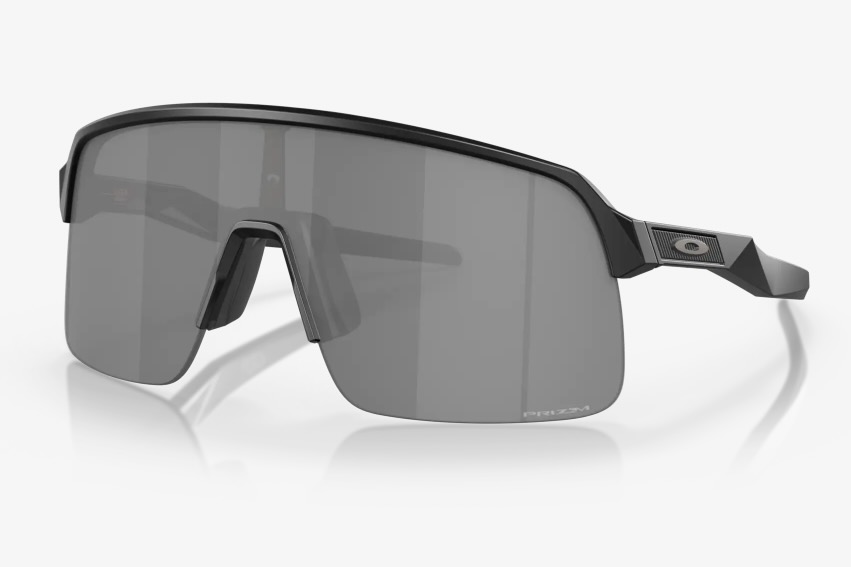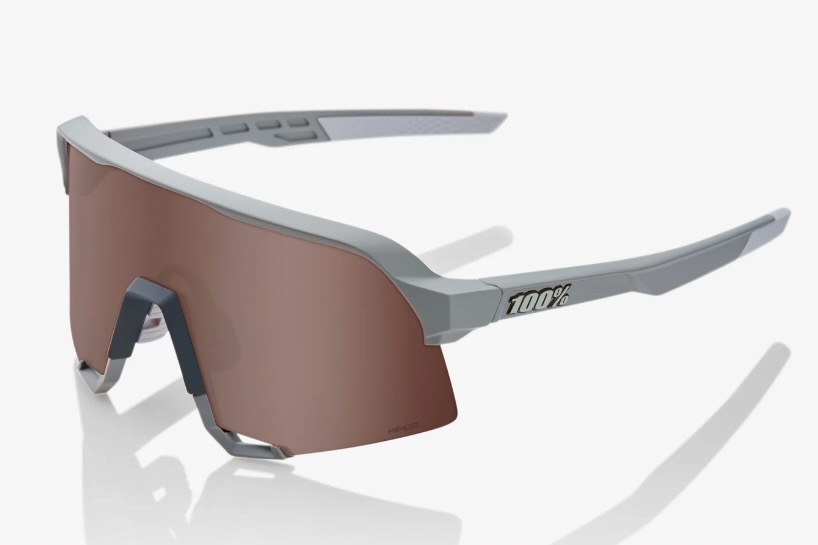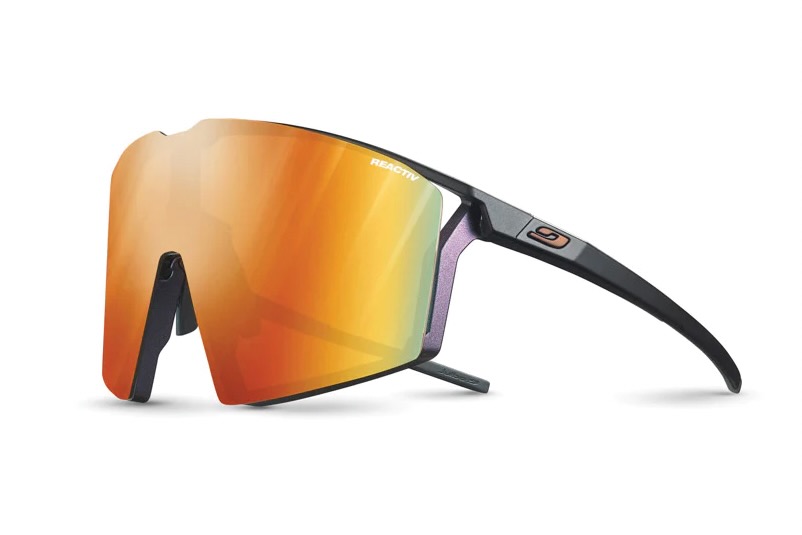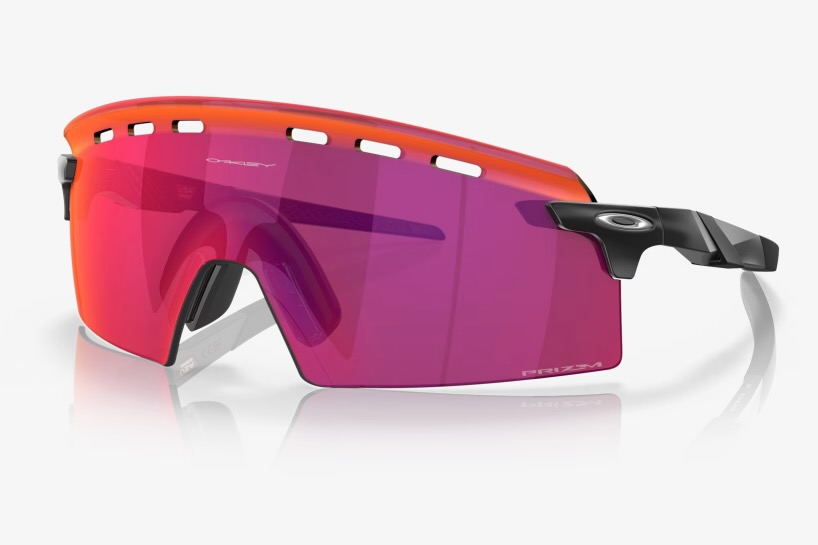No matter what type of cycling you do, protecting your eyes from the sun, wind, and debris is important for both comfort and safety. Fortunately, there are loads of great cycling sunglasses on the market to choose from that come in a wide range of styles, lens tints, and sizes to suit varying needs, preferences, and budgets.
Quality cycling sunglasses have excellent optics that dim harsh light and boost contrast, provide coverage and protection from the wind, dust, bugs, and other debris, fit comfortably, and go virtually unnoticed while riding. These days we have more great options than ever with numerous brands putting out quality eyewear with different frame styles, lens sizes, lens tints, and contrast-enhancing technologies, all with the same goal of helping you see more clearly while you ride.
With so many options, finding the right pair of cycling sunglasses for your face, riding style, and light conditions can be a challenging proposition. To help, we gathered a diverse selection of 14 of the best models on the market in 2023 for testing and comparison. Whatever your favorite riding discipline, there are lots of excellent options to shield your eyes while you’re out on the bike.
After testing these cycling sunglasses for months, we zeroed in on our favorites which are listed below, followed by the best of the rest that are all very worthy of consideration as well. To see the specs of all the models we tested at a glance, check out our comparison chart. If you need some help figuring out what you need, our detailed buying advice and FAQ section have answers to steer you in the right direction.
The Best Cycling Sunglasses of 2023
- Best Overall Cycling Sunglasses: Julbo Density
- Best Full Frame Budget Cycling Sunglasses: Tifosi Sledge
- Best Full Coverage Cycling Sunglasses for Mountain Biking: POC Devour
- Best Budget Frameless Cycling Sunglasses: Tifosi Rail
- Best Optics: Oakley Sutro Lite and Oakley Sutro Lite Sweep
- Most Versatile Cycling Sunglasses: Smith Wildcat
- Best Cycling Sunglasses for Bold Style: 100% S3
- Best Cycling Sunglasses For Smaller Faces: Rapha Pro Team Full Frame
Pros
- Ultra lightweight
- Great optics
- Very stable on the face
- Large coverage
Cons
- Inner lens is oddly difficult to clean
- Only 1 lens included

Tifosi Sledge
Pros
- Reasonable price
- Good optics
- Tough feeling frame
Cons
- Heavier weight
- Limited contrast boost
- Frames may contact some people's cheeks
- Brand lacks "cool-factor"
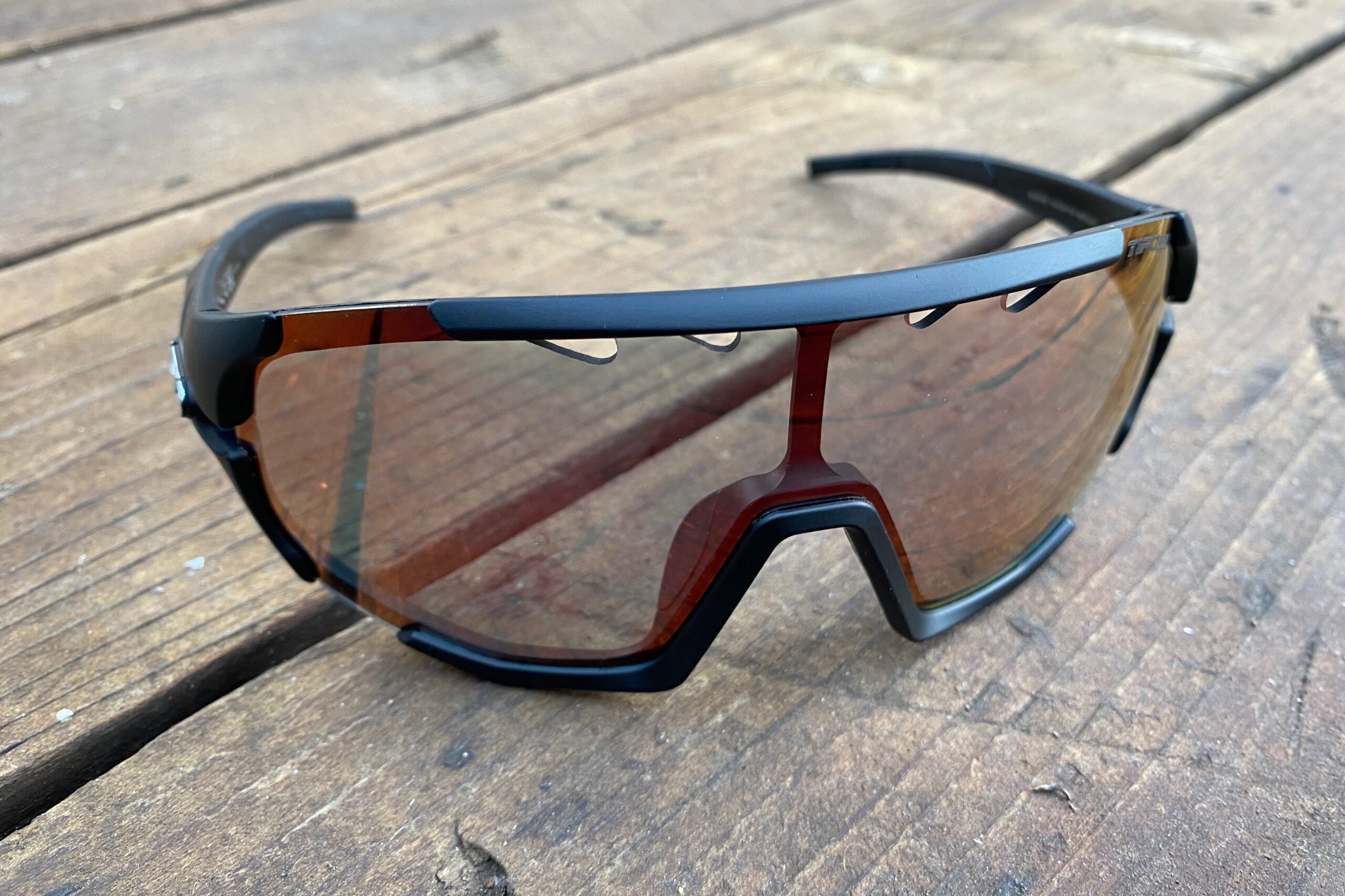
POC Devour
Pros
- Massive, goggle-like coverage
- Great optics
- Adjustable length arms
- Curved and dropped arms avoid contact with helmets
- Lots of frame color and lens options
Cons
- May be too large for smaller faces
- Frame visible in periphery
- Expensive
- No storage case included
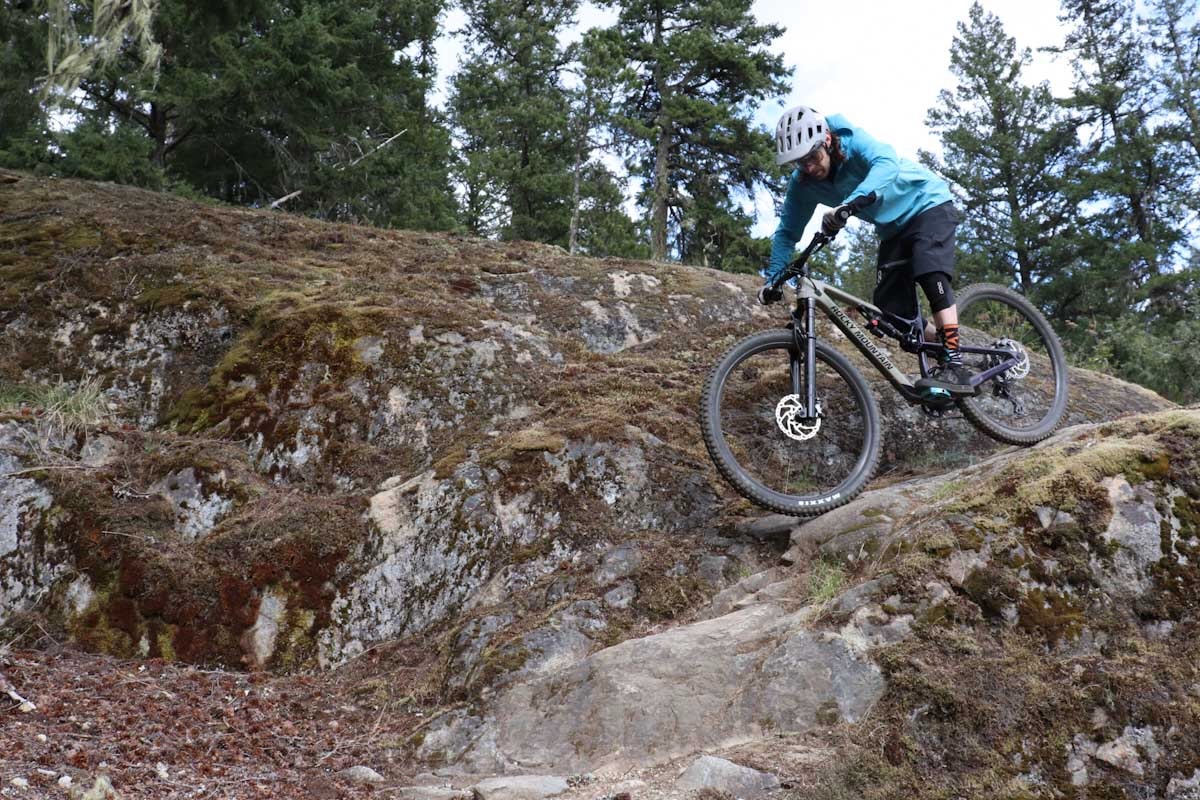
Tifosi Rail
Pros
- Reasonable price
- 3 lenses included (Interchange models)
- Large coverage
- Good optics
Cons
- May be too large for smaller faces
- Limited contrast boost
- Less stable over rough terrain

Oakley Sutro Lite
Pros
- Fantastic optics
- Excellent coverage
- Great peripheral vision
Cons
- Long arms may conflict with some helmets
- Expensive
- Only come with one lens

Smith Wildcat
Pros
- Highly versatile
- Great coverage
- Comes with 2 lenses
- Stylish
Cons
- Have seen some arms break
- May be too big for small faces

Pros
- Bold style
- Large coverage – great wind protection
- Great optics
Cons
- Long arms may conflict with some helmets
- May be too large for smaller faces

Rapha Pro Team Full Frame Glasses
Pros
- Great optics
- Versatile lens
- Very stable on the face
- Shorter arms unlikely to conflict with most helmets
- Smaller lens dimensions may be a plus for some people
Cons
- Edge of lens vent visible in peripheral
- Smaller lens dimension may be a negative for some people

Smith Momentum
Pros
- Excellent wind protection
- Great peripheral vison
- 2 lenses included
- Crystal clear optics
- Arms don't conflict with any helmets
Cons
- May be a little narrow for wide faces
- Lens may touch some people's cheeks
- Very hard to change lenses
Pros
- Stable in use
- Great optics
- Great coverage and wind protection
- Lots of frame color and lens options
Cons
- Bold style may not be for everyone
- Lenses are very reflective
- Only come with a microfiber bag – no case
Pros
- Magnetic lens – easy lens changes and cleaning
- Lightweight
- Brightening lens
Cons
- Glare on lens in direct sunlight
- Lens may contact some people's nostrils
- Expensive (for Reactiv lens models)
Pros
- Shorter arms less likely to conflict with helmets
- Clear optics
- Built in USA
- Great wind protection
Cons
- Expensive
- Bold style may not be for everyone
- Only 1 lens included
Pros
- Close, wraparound fit
- Flashy style
- Great contrast
Cons
- Expensive
- Only one lens included
- Some distortion around the curves in the lens
- Polarizing aesthetics
Pros
- Very lightweight
- 2 lenses included
- Clear optics
Cons
- Narrow bridge fit
- Not as stable over rough terrain
- Feel a little fragile
Cycling Sunglasses Comparison Chart
| Model Name | MSRP | Frame Style | Lens Dimensions | Lens tested | Lenses included | Measured Weight |
|---|---|---|---|---|---|---|
| Julbo Density | $170 – $250 | Half frame | 140 x 59mm | Reactiv 0-3 High Contrast | 1 | 19 grams |
| Tifosi Sledge | $80 | Full frame | 135 x 56mm | Clarion Fototec Red | 3 (Interchange) or 1 (Fototec) | 37 grams |
| POC Devour | $250 | Full frame | 177 x 66mm | Clarity MTB Silver Mirror | 2 | 40 grams |
| Tifosi Rail | $80 | Frameless | 138 x 59mm | Blackout Interchange | 3 (Interchange) or 1 (Fototec) | 31 grams |
| Oakley Sutro Lite | $194 | Half frame | 139 x 58mm | Prizm Black | 1 | 32 grams |
| Smith Wildcat | $209 – $229 | Full frame | 140 x 62mm | Photochomic Clear to Gray | 2 | 28 grams |
| 100% S3 | $185 | Half frame | 145 x 60mm | HiPER Crimson Silver Mirror | 2 | 34 grams |
| Rapha Pro Team Full Frame | $188 | Full Frame | 130 x 53mm | Pink Blue lens | 2 | 31 grams |
| Smith Momentum | $209 – $229 | Half frame | 135 x 65mm | Photochromic Clear to Gray | 2 | 33 grams |
| KOO Demos | $150 – $200 | Full frame | 143 x 60mm | Turquoise, Red Mirror | 1 | 32 grams |
| Julbo Edge | $185, $260, $290 | Full frame | 130 x 64mm | Reactiv 1-3 Light Amplifier | 1 | 24 grams |
| Roka CP-1X | $230 – $250 | Full frame | 140 x 56mm | Glacier Mirror | 1 | 27 grams |
| Oakley Encoder Strike | $264 | Frameless | 138 x 56mm | Prizm Road | 1 | 31 grams |
| 100% Hypercraft SQ | $155 – $185 | Frameless | 138 x 55mm | HiPer Red Multilayer Mirror | 2 | 21 grams |
Why Should You Trust Bikerumor?
For well over a decade, the team at Bikerumor has been reporting on the latest news, trends, technology, and products across all disciplines of cycling. Writing about bikes and all the gear that goes along with them isn’t just our job, it’s also our passion, and we’re always seeking the best products to enhance our comfort, performance, and safety on our rides. Quality eyewear is a critical piece of gear that we rely on to protect our eyes from the elements so we can see clearly and focus on the task at hand.
Our cycling sunglasses buyer’s guide author, Jeremy Benson, has been reviewing cycling gear for the past seven years and has personally tested over 30 different pairs of performance eyewear. An obsessive mountain and gravel rider, Benson spends an inordinate amount of time on the bike each year while testing various products, training for the next race, or riding just for fun. Living in the Sierra Nevada mountains in Truckee, CA, just north of Lake Tahoe, there is world-class riding on hundreds of miles of trails, gravel, and paved roads just out his front door, providing an excellent testing ground to put any bike, component, or accessory through its paces. While riding bikes for the past 30 years, Benson has seen the evolution of cycling sunglasses firsthand and knows the importance of having the best eyewear to see clearly and perform at his best. As a contact lens wearer, the right eyewear is particularly critical as he is extra sensitive to wind and dust that can cause irritation and impact his eyesight on the road or trail. In addition to cycling sunglasses, Benson has also reviewed the best mountain bike shoes, protective mountain bike helmets, and hitch bike racks to transport your fancy bikes.
For the purposes of this buyer’s guide, we rounded up 14 of the best cycling sunglass models available in 2023 for testing and comparison. Over the course of several months, each model was thoroughly tested, scrutinized, and analyzed on gravel, road, and mountain bike rides ranging from casual rips with friends to grueling endurance races. Switching between models frequently provided the opportunity to compare them directly when considering optics, fit, coverage and eye protection, frame designs, and stability in use. As it turns out, there are lots of excellent options on the market, and plenty more that we haven’t tested yet, to shield your eyes from the sun and wind no matter your fit, coverage, or style preferences.

Buying Advice: How To Choose Cycling Sunglasses
With hundreds of different models of cycling sunglasses on the market, choosing the right pair can be a daunting task. The different frame styles, lens sizes, shapes, tints, coatings, grippers, etc., are enough to make your head spin. To help you understand, we’ll break down some of the important things to consider when searching for your next pair of riding shades.
Lenses
Lenses are arguably the most important element of any pair of cycling sunglasses, providing the windows through which you view the world. These days, pretty much every brand is producing quality lenses with clear, distortion-free optics, but they vary in many ways. When considering your next pair of shades, there are several lens-related factors to take into account.

Contrast Enhancement
Most good lenses feature some type of contrast enhancement technology that is intended to boost contrast, definition, and colors. This is done through a combination of lens tint, filters, and coatings to manipulate the light that passes through the lenses to our eyes. Oakley’s Prizm and Smith’s Chromapop are two of the more recognizable lens technologies and arguably two of the best at their intended purpose, effectively making everything appear to be in high definition. Other brands have similar technologies, including 100%’s HiPER, POC’s Clarity, and Julbo’s Spectron 3, as examples. While they all intend to do the same thing, they all perform slightly differently but still work to enhance your vision out on the road or trail.
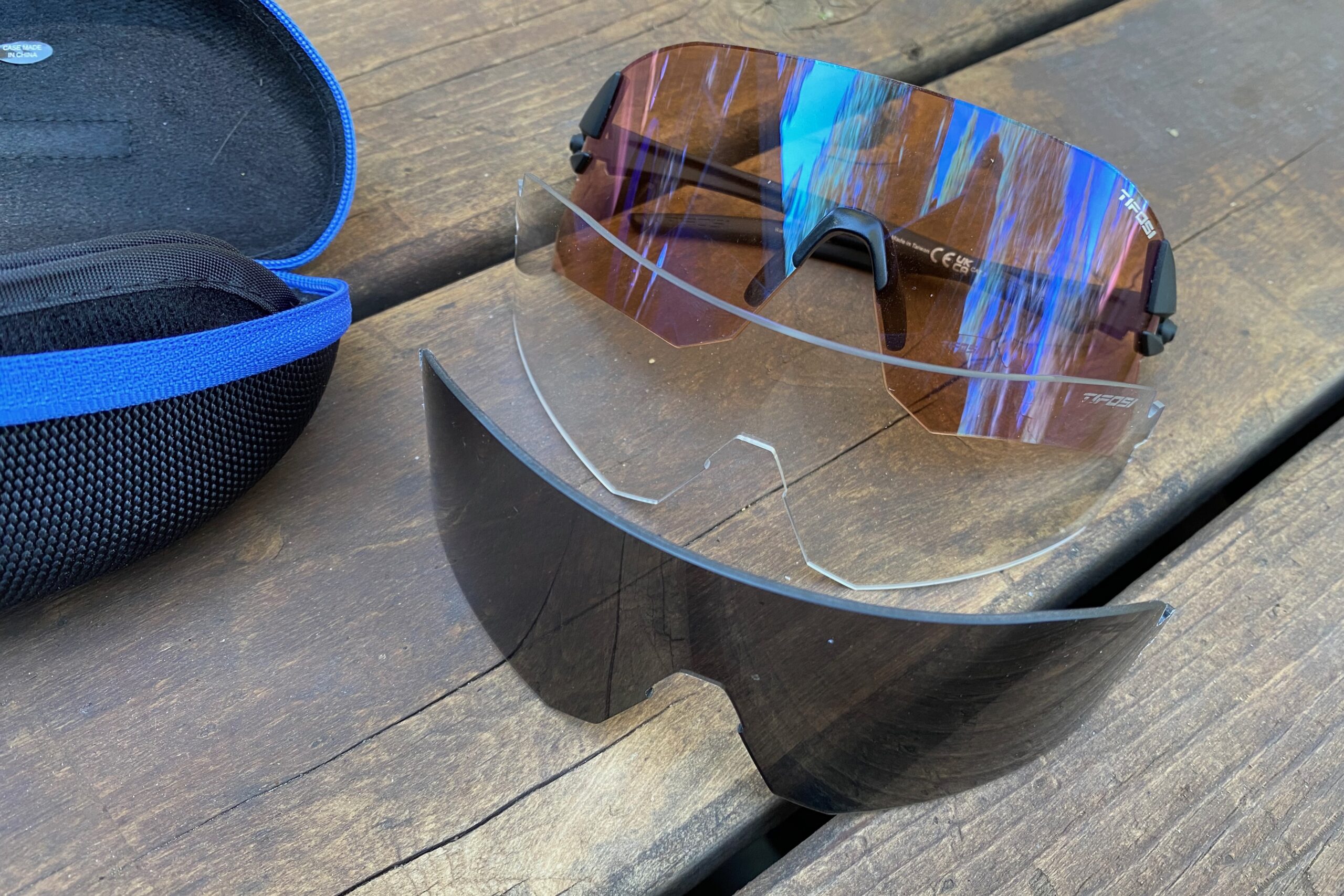
Tint
The tint/color of a lens is an important consideration, not just for how the glasses look, but for how the world looks when you look through the lenses. The tint of a lens impacts the colors you can see, with some being better suited to bright conditions and others working well for low-light situations. Brown/amber and grey are two of the most common lens tints for bright to moderately bright light conditions. Grey lenses tend to have more of a cooling effect while brown makes things look a little warmer. For low light, yellow and rose tints are often preferred for their ability to brighten things up. Clear is another popular lens for dim light, and many glasses come with a clear lens that can be swapped out for the bright light lens for those situations.
Visible Light Transmission (VLT)
VLT refers to the amount of visible light that is able to pass through the lens and it is shown as a percentage. A lower number, 10% – 15%, for example, means less light is passing through to the eyes, and these lenses will be best for bright light conditions. Bright, sunny days out on paved or gravel roads with little shade are where lenses with low VLT work best. Higher VLT numbers are typically seen on lenses intended for use in low-light conditions where you want more of the visible light to help you see more clearly. Cloudy days, shady forests, and dawn/dusk are good applications for lenses with higher VLT numbers. Photochromic lenses (more on this below) change tint depending on the ambient light conditions, and most can span a huge VLT range to work well in any light condition. The Reactiv High Contrast 0-3 lens of the Julbo Density, for example, has a massive claimed VLT range of 12% – 87%.

Photochromic
Photochromic lenses are those that change tint depending on the light conditions. This type of lens aims to have you covered for any and all light conditions that you may encounter while outdoors without the need to change lenses. While they vary, most of these lenses can transition from essentially clear to relatively dark depending on the ambient light conditions. The Smith Wildcat, for example, can be purchased with a photochromic lens that has a VLT range of 20% – 85%. Similarly, we tested the Julbo Density with the Reactiv 0-3 High Contrast lens that has a claimed VLT range of 12% – 87%. Most brands offer a photochromic lens option in addition to the other lenses they produce. It is worth mentioning that photochromic lenses don’t transition instantly, it takes several seconds for them to adapt to major changes in light conditions.
Polarized
Polarized lenses are those that block horizontal light waves with the goal of eliminating reflection and glare. This type of lens is particularly useful for water activities like fishing or boating because it helps you see through the water’s surface. They work well enough for cycling too, but they are not generally considered a must-have.
Material
Sunglass lenses can be made from glass, polycarbonate, or plastic, with the overwhelming majority of sport/performance sunglasses using polycarbonate lenses. Polycarbonate is the material of choice because it is lightweight, impact-resistant, and can be made into interesting shapes and the large lenses of modern cycling sunglasses. Glass lenses may still be used in some high-end sunglasses, but given the fact that glass can shatter, it is not ideal for cycling or other activities with the chance of impact. Some very cheap sunglasses use super basic plastic lenses, but they tend to have very poor optics/clarity and durability.

Lens Shape
The lenses of sport sunglasses all have some sort of curvature to them, and the shape of the lens will either be Cylindrical, Spherical, or Toric. The lens shapes are visibly aesthetically different, and they aim to provide clear optics in different ways. Cylindrical lenses are the most basic and they are curved on the horizontal plane while being flat on the vertical plane. While most cylindrical lenses provide excellent, clear optics, they historically have been more prone to distortion than other styles (though recently most perform on par with other lens shapes). Spherical lenses are curved on both the horizontal and vertical planes giving them a rounded, bubble-like shape. The shape is intended to better match the eye and the angles you’ll be looking out of them in the periphery for less distortion. Toric lenses are very similar to spherical lenses because they are also curved on both the horizontal and vertical planes but with more horizontal curve than vertical. These lenses aim to provide the benefits of a spherical lens while being a bit less bulbous in its shape.
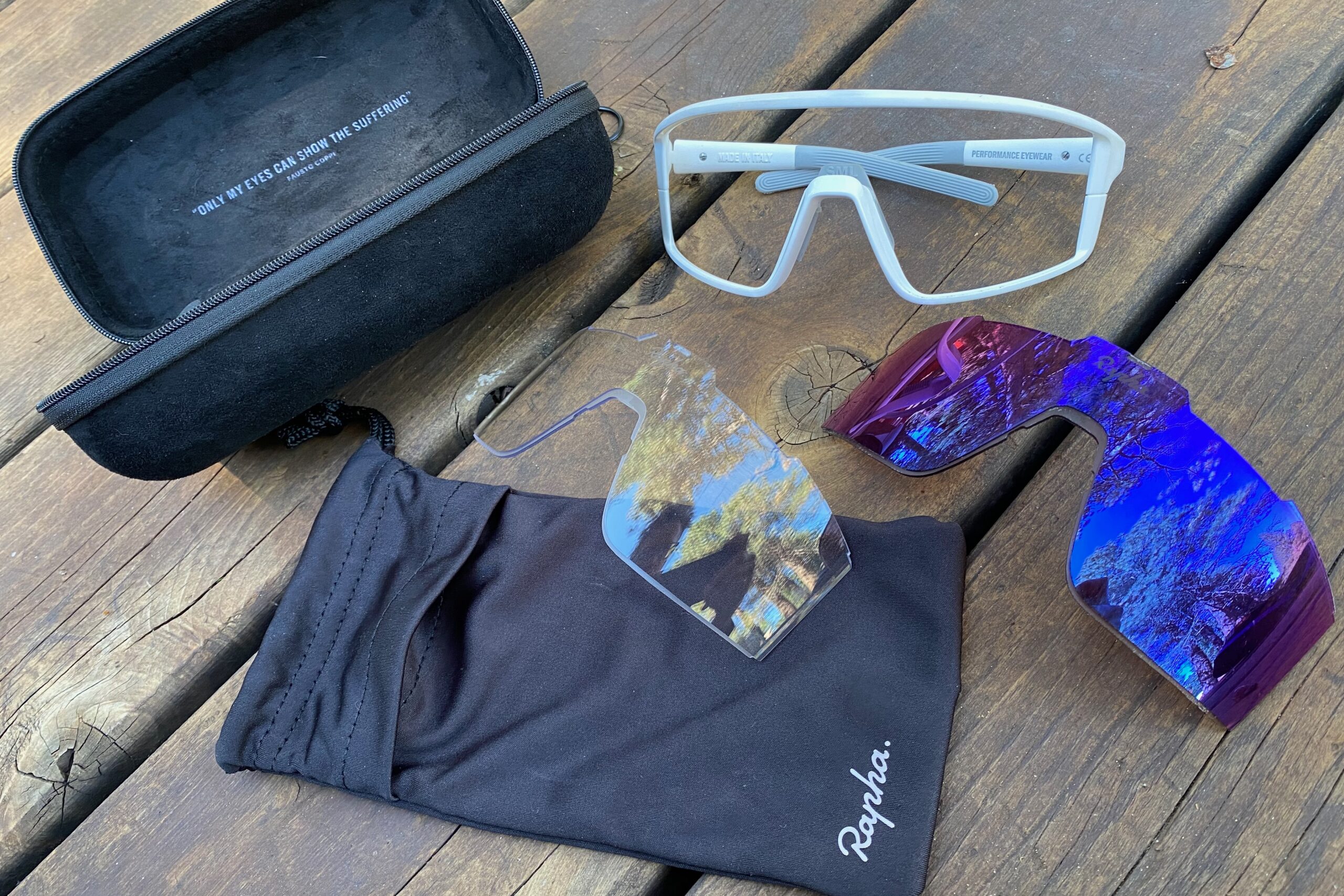
Interchangeable Lenses
Many cycling sunglasses allow you to change lenses, and many come with an additional lens (or two) for use in different light conditions. Even if the sunglasses you buy don’t come with any extra lenses, most brands sell replacement lenses should yours get damaged or you want to get something that better suits the light conditions in which you ride. The frame style and lens design will dictate how easy it is to change lenses, with some being very quick and easy and others presenting some difficulty.
Fit
A well-fitting pair of sunglasses should essentially go unnoticed while riding so you can focus on the road or trail ahead of you. It is important for them to be comfortable, protect us from the sun and wind, and remain secure and stable in use. Our head shapes and facial features vary, of course, so trying on a pair of sunglasses may be the best way to determine if they are the right fit for you.

Coverage
In recent years, cycling sunglasses have been getting bigger and providing more coverage with some even resembling a pair of goggles. There’s a good reason for this. The larger the lens and greater the coverage, the more protection it provides from the sun, wind, dust, bugs, and debris that may otherwise impact your eyes and vision. This is particularly important when traveling at high speeds where watery eyes could impact your ability to see the road or trail. It isn’t just about lens size, however, as the shape of the lens and how close it fits to the face plays a role as well.
While coverage preferences vary in terms of style and fit, today’s large-lensed glasses do a great job of protecting the eyes. For those who aren’t on board with the big coverage trend, there are still loads of small to medium-lensed options on the market to suit all preferences.

Size
Heads come in a range of sizes, and not every pair of cycling sunglasses will work perfectly for everyone. An important factor to consider here is the lens size, as some of the largest models may simply be too big for those with smaller faces/heads, and vice versa. A lens that is too large may contact your checks, brow, or even your helmet, while a lens that is too small may not provide ample protection from sun or wind. Similarly, you don’t want a pair of sunglasses that squeezes your head too tight or not enough to remain comfortable and stable in use. Thankfully, there are enough options on the market that everyone should be able to find glasses that work for them.

Stability
A well-fitting pair of sunglasses should be comfortable and remain stable while you’re riding without slipping or bouncing out of place over rough sections of trail or a bumpy gravel road. One of the main factors in this equation is the nose pads and arms that are almost always topped with grippy hydrophilic (stays grippy when wet) rubber where it contacts your skin. Additionally, many sunglasses feature adjustable, or swappable, nose pads to suit different-shaped nose bridges to optimize the fit to your face. Some sunglass arms are also adjustable and can be bent slightly to better match the contours of your head, and a select few have an adjustable temple length as well. Another factor is how much the sunglass arms squeeze your head which is related to the width of the sunglasses and how much tension is present in the frame/lens and the width of your head.

Frame
Cycling sunglasses come in a variety of frame styles including full-frame, half-frame (top or bottom), and frameless designs. While differences are mostly aesthetic, there are some other things to consider.
As the name suggests, full-frame glasses have a frame that wraps around the entire perimeter of the lens either along the edge or right behind it. In addition to protecting the edge of the lens, frames like these add structure and rigidity to the glasses. The drawbacks to full frames, however, are that the additional plastic adds weight, sometimes the frame can be visible in the periphery, it can serve as a spot for sweat to pool if it drips on the lens, and cleaning the edges of the lens can be slightly more difficult. Models like the Tifosi Sledge, Roka CP-1X, Smith Wildcat, and Rapha Pro Team Full Frame feature full-frame designs.
Half-frame designs typically do away with half of the frame, either the top or the bottom, in an effort to save weight and reduce the amount of frame that could potentially be visible from certain angles. The part of the frame that remains helps add some structure to the lens and is typically a bit easier to clean the lenses. The Oakley Sutro Lite, Sutro Lite Sweep, Julbo Density, and the Smith Momentum are examples of half-frame designs.
Frameless sunglasses usually consist of a lens with just arms and a nose piece attached. The lack of a frame makes it virtually impossible to see it in your peripheral vision while also making it super easy to clean the lenses. Typically, this style makes for very easy lens changes as well. Examples of frameless models include the Tifosi Rail, Oakley Encoder Strike, and the 100% Hypercraft SQ.
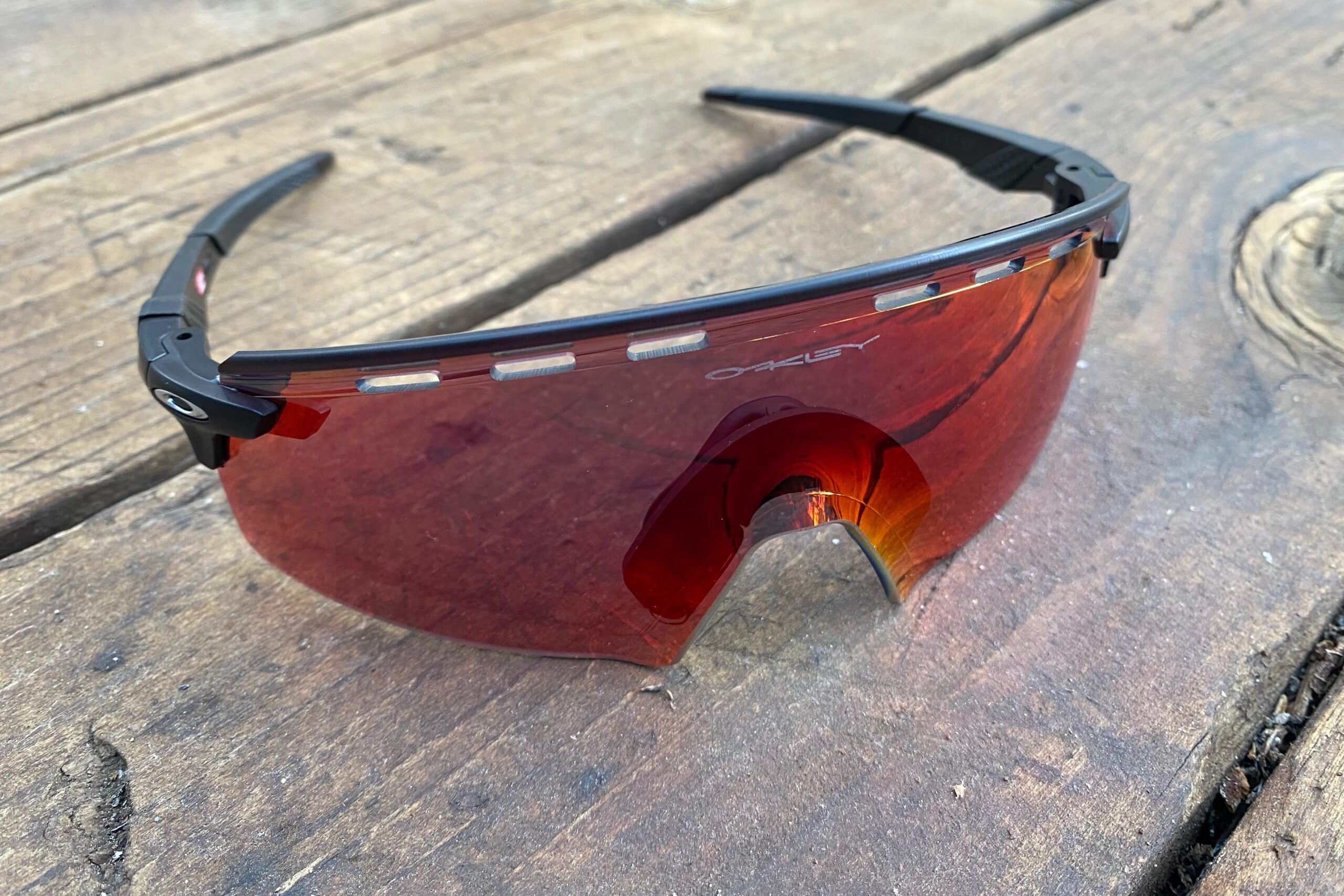
Arms
Sunglass arms are a critical element of the frame that helps keep them in place while riding. They extend back from the upper corner or side of the lens or frame and contact the head right above your ears. Most have rubber grippers that add some traction and help to keep them in place. They vary a bit in terms of length and shape depending on the model/brand. Depending on the size of your head and/or the helmet you wear, the length of the arms could be an important consideration. Long, straight arms can make unwanted contact with the shells or the adjustment systems on some helmets. Some models of glasses, like the Rapha Pro Team Full Frame and the Roka CP-1X, have purposefully shorter arms that still provide a comfortable and secure hold of the head while avoiding helmet contact. Similarly, some glasses have dropped arms that are positioned lower to try and prevent unwanted contact with helmets near the temples. The Smith Momentum and POC Devour both feature this design that plays well with today’s extended coverage half-shell mountain bike helmets.

Materials
The majority of cycling sunglass frames are made from similar lightweight plastic or polycarbonate materials. Grilamid TR-90 is one of the most common materials used that is chosen for its low weight and durability. Some brands have created their own proprietary frame materials, like Oakley’s O-matter or 100%’s Ultracarbon, or make their own blends like the Grilamid and TPU frame of the Smith Wildcat.
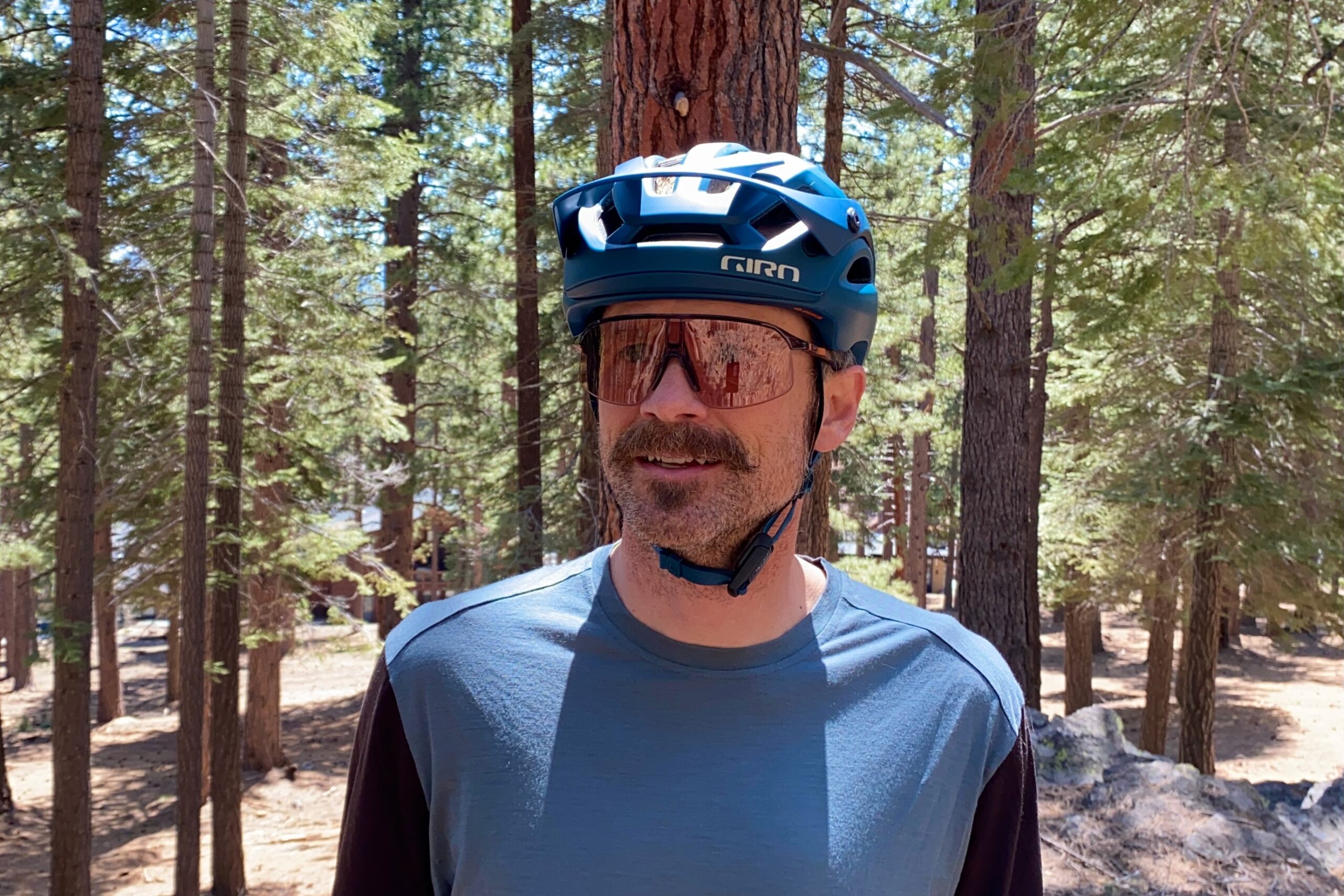
Weight
Compared to many other things in cycling, the weight of your sunglasses is relatively inconsequential and the differences between models are quite small. The glasses we tested range from the featherlight Julbo Density and 100% Hypercraft SQ at just 19 grams and 21 grams, respectively, up to the comparatively heavy POC Devour at 40 grams. While sunglass weight is hardly a consideration, the differences are somewhat noticeable in use, especially when switching between models frequently. Will 20 extra grams slow you down? No, but they do feel a little heavier on the face.
Style
We all want to look good when we’re riding our bikes, right? Okay, maybe some people could care less, but like it or not, style matters. Since style is a personal thing, it’s up to you to decide what looks good and what doesn’t, and our opinions will likely be influenced by what our friends wear and the non-stop marketing machine of the eyewear industry. The good news is that no matter what your personal aesthetic is, there are cycling sunglasses to match. They come in various shapes, sizes, frame designs, lens tints, reflective coatings, and brands that you’re sure to find something you like out there.

Value
There’s no two ways about it, quality eyewear can be expensive. You can easily spend upwards of $200 on a slick new set of cycling sunglasses, but you certainly don’t have to. Yes, many of our top picks are on the higher end of the price spectrum thanks to their excellent optics, great coverage, and great on-the-bike performance, but there are several manufacturers putting out great models at more reasonable prices. Tifosi is one such brand that sells its glasses at a fraction of the cost of the more expensive competition while leaving little, if anything, to complain about performance-wise. At just $80, both the Tifosi Rail and the Tifosi Sledge perform similarly to the more expensive models we tested, plus they can be purchased with either a single Fototec photochromic lens or Interchange with 3 lenses included.
Frequently Asked Questions About Cycling Sunglasses
Realistically, you can wear any sunglasses you like while cycling. Some $20 gas station shades will probably protect your eyes better than not wearing any glasses at all. Still, there’s a reason that cyclists buy sunglasses that are made for cycling. Modern lenses provide excellent optics that enhance definition, boost contrast, and bring up colors, and they come in a vast array of tints, reflective coatings, and VLTs to suit every light condition imaginable. Cycling sunglasses are also designed with large lenses that provide excellent coverage to keep, the sun, wind, dust, etc., out of our eyes so we can see clearly and focus on the road or trail ahead. Specially designed rubber nose pads and arms provide security and stability over rough terrain and can often be adjusted to optimize the fit for your face. Not to mention the fact that many of them look pretty cool too.
Many cycling sunglasses are quite expensive, but some brands are disrupting the market with less expensive options that perform nearly on par. Yes, one of the things you are paying for with high-end models is the brand name and supporting their marketing budget so they can sponsor pro teams, events, and the like. That said, there is also some serious research and development that goes into top-tier lenses and sunglass designs. The most expensive models also often feature better coatings that help to resist fogging, scratching, water, etc, which can help them perform better in the field.
There is no single lens that will be perfect for all riding scenarios, but thankfully there are so many options that you should be able to find one that is perfectly suited to the riding you do. For people who ride in a wide range of light conditions, photochromic lenses are a good option since they change to suit the current light conditions and will have you covered for most scenarios. Likewise, glasses that come with multiple lenses are a good choice because you can change out the lenses to suit the light conditions of the day. Otherwise, try and pick a lens that’s best suited for the light conditions that you’ll be encountering most often, and potentially consider getting an additional lens you can swap out if/when needed.
Some sunglasses brands are making their sport/performance sunglasses with prescription lenses. If you do a little online research you can easily find numerous models that can be made with a corrective lens. Additionally, many other models are capable of accepting a prescription lens insert.






